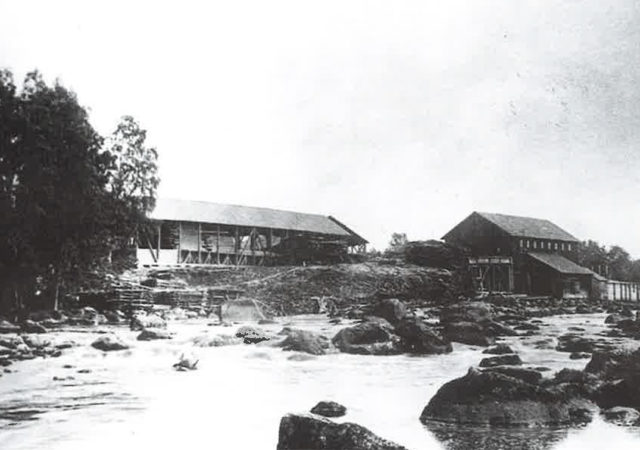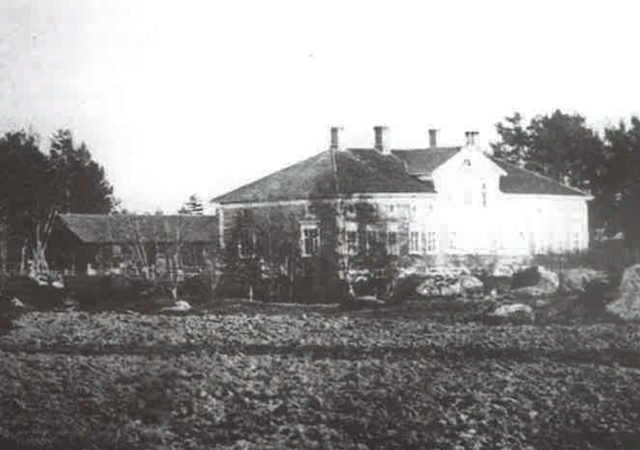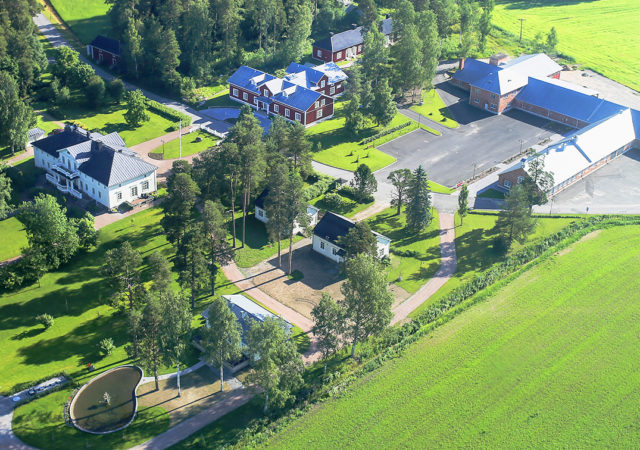The Keppo Mansion
The Keppo Mansion, situated in Jepua, Uusikaarlepyy, is one of a few mansions left in Ostrobothnia. It is used for KWH Group’s representative purposes. The Board of Directors of KWH Group Ltd meets regularly at Keppo Mansion as well.

1739–1783 Sawmill and textile industry
The Keppo mansion is one of a few mansions in the Ostrobothnia. The mansion has never had large-scale farming but has for centuries been characterized by minor-scale industrial activities.
The base of the activities has been access to water power from the Keppo rapids in the Nykarleby river. The combination of water power and availability of the timber forest, in addition to the relatively close shipping port in Nykarleby, resulted in the first fine blade water sawmill at the Ostrobothnia rapids in about 1739. The builder was alderman Samuel Lithovius in Nykarleby. Timber was floated along the river as far as Lapua and Kuortane.
The sawmill was developed during the time of the owner Johan Bladh the younger (1762-1783). At this time a tobacco plantation, spinning mill, pitch works and a linen-/cotton-/ textile mill were set up. Johan Bladh was a merchant and shipowner in Vaasa, who moved later to the Benvik farm close to the town of Kaskinen where he died in 1783.

1786–1838 The era of Björkman family
The year 1786 was the turn of the family as Björkman joined the owners. Merchant Bengt Magnus Björkman, who settled in Stockholm, bought the Keppo sawmill. In Finland he also owned Orisberg, which is to this day in the possession of the family (ennobled under the name of Björkenheim in 1834). Additionally, the family acquired the Kimo mill in 1776, Fiskars in 1783, the Koski mill in Bjärnå and the Orijärvi mine. In Sweden the family owned many iron mills and estates.
The son Lars Magnus Björkman owned Keppo until 1829 when the sawmill was sold to Gustaf Adolf Lindqvist, a merchant and shipowner from Nykarleby.

1838–1899 The Mansion got its first inhabitants
Lindqvist sold the mansion and industrial establishment to Carl Otto von Essen, a bookkeeper at the Kimo mill. None of the above mentioned owners had lived at the farm. However, Otto von Essen broke this tradition and moved to the residental building, which was in disrepair. The building was situated on a hill, close to the industrial buildings, about 200 meters north of the present mansion.
In 1869 the old Keppo mansion, the saw and other buildings were burnt down to the ground. The saw was immediately rebuilt. The character building was not rebuilt at site. Instead, another smaller building, which was situated where the Keppo mansion now lies, was enlarged in length and width. The frame of today’s Keppo mansion originates from the end of the 1860’s.
During the time of Otto von Essen the sawmill experienced its boom. Peter Malm Junior in Jakobstad, a well-known shipowner and industrialist, became a corporate member at the sawmill in 1840. Mr Malm financed the sawmill and sold the finished products. Von Essen was a saw inspector and bought timber. His brother-in-law, Johan Vilhelm Snellman, lived at the Keppo mansion in 1839 and even worked as a temporaty saw inspector when Otto von Essen was ill.
In the 1860s, the annual production exceeded ten thousand logs.
The co-operation between the two owners was not without problems and in 1876 the entire sawmill was taken over by the company, Petter Malm Jr. A fire in 1893 confirmed the destiny of the sawmill. Since the fire there has been no working sawmill at the Keppo rapids.
There was, however, enough surplus water power for something else; a customs mealmill was founded opposite the sawmill in 1831. In 1851 an oilmill was set up for the manufacture of linseed and hemp oil. This mill was destroyed by fire in 1880 and was not rebuilt.

1899–1954 From spinning mill to a High School
The family von Essen owned the Keppo mansion until 1899 when the factory owner Hugo Grönlund was recorded as a new owner. Also this time, the temptation was water power. In the autumn of 1900 “Hugo Grönlund’s woollen spinning mill“ started its operation in a newly-built factory, with two floors, in the plot of the former owner. After the weaving mill, the name was changed to “Jeppo Cloth Factory”. The maximum number of employees was 50. In April 1909 fire destroyed the factory again and it was burnt down. The operation was moved to Seinäjoki.
Before the fire the agricultural land and forest were sold to the company Wilhelm Schauman Ab in Jakobstad in 1906. The company was interested in the forest. After Viktor Schauman had bought the Keppo Mansion in 1918, the renovation of the farm, house and outhouse buildings, were started. Viktor and Ragni Schauman lived at the mansion until 1930, when they were obliged to sell Keppo.
The character building now became a school building for The Evangelical High School, which was owned by the guarantee association for the period 1930-1942. After a period as army accommodation during the war, the house which was in disrepair, was taken into use by the former owners. The Viktor Schauman family lived at the mansion until 1954.

1954–1994 The Keppo Ltd
The year 1954 was the start of a new era for the Keppo Mansion. Emil Höglund and Karl-Johan Tidström bought the mansion with its property, 37 hectares of cultivated land and 418 hectares of forest, on account of the newly established company Keppo Ltd.
A mink farm was set up. This was built rapidly and in 1962 the farm was the biggest in the world. A maximum of 130,000 skins were produced in the 1970’s. The annual production of all the Keppo farms was 480,000 mink- and 150,000 fox skins. 1992 ended the farming of Keppo (since 1985 KWH Group Ltd). The mink farm, which stands close to the mansion, is now hired and the operation continues on a smaller scale.

1994– Representative locals
The Keppo Mansion is presently used for the KWH Group’s representative purposes. It hosts meetings and accommodates the guests of the KWH Group. A separate Guest House has been built on the Mansion’s premises and there is also the opportunity to visit the KWH Group’s own museum. The former stable has been renovated to accommodate meeting, banquet and exercise rooms. Keppo Brewery operates as a tenant in a part of the stable since 2017.
